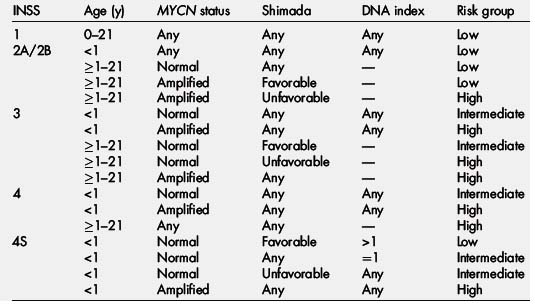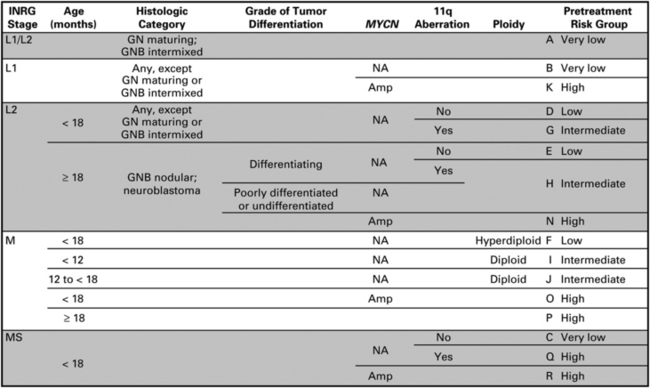Neuroblastoma
Epidemiology
Neuroblastoma is the most common extracranial solid tumor in infants and children, representing 8% to 10% of all childhood tumors. It accounts for approximately 15% of all cancer-related deaths in the pediatric population [1]. The incidence of neuroblastoma is 10.2 cases per million children under 15 years of age [2], and nearly 500 new cases are reported annually. Although 90% of cases are diagnosed before 5 years of age, 30% of those are within the first year. The median age of diagnosis is 22 months [3]. Rarely does it present in adolescence and adulthood, but outcomes are much poorer in this age group. There does not appear to be an increased prevalence among races, but there is a slight predilection for boys (1.2:1.0) [1].
With a family history noted in 1% to 2% of diagnoses, there are reports of autosomal dominant patterns of inheritance [3]. In such pedigrees, patients are frequently diagnosed at an earlier age (median age of 9 months) than those with sporadic disease and are more likely to have multiple associated primary cancers. Neuroblastoma has also been diagnosed in conjunction with other congenital conditions, such as Hirschsprung disease, congenital hypoventilation disorder, and neurofibromatosis type 1 [1]. There was early interest in the co-occurrence of neuroblastoma and neurofibromatosis, as they are both disorders of neural crest cells. However, this may represent coincidence rather than a true association [4].
Outcomes in patients with neuroblastoma have improved steadily over the last 30 years with 5-year survival rates rising from 52% to 74% [2]. The improvement is likely secondary to improved cure rates in the low-risk group, who have survival rates of up to 92%. It is estimated that 50% to 60% of patients in the high-risk group experience relapse [2], and as such, they have only seen a modest decrease in mortality. In a study by the International Neuroblastoma Risk Group, the median time to relapse was 13.2 months, and 73% of those who relapsed were aged 18 months or older. Taken together, their overall survival rates remain quite abysmal (∼20% at 5 years) despite more aggressive therapies [5].
Clinical presentation
Multiple factors play into a patient’s clinical presentation because it depends largely on tumor location, size, degree of invasion, effects from catecholamine secretion, and symptoms caused by paraneoplastic syndromes. Nearly 65% of tumors arise in the abdomen with half of those localized to the medulla of the adrenal gland. However, they can occur in the neck (5%), chest (20%), or pelvis (5%), and 1% of patients have no detectable primary [1,6]. Many patients are asymptomatic, yet some may present with constitutional symptoms (malaise, fevers, and weight loss), an enlarging mass, pain, abdominal distension, lymphadenopathy, or respiratory distress secondary to compression or hepatomegaly. Pelvic masses may cause constipation or difficulty with urination, whereas thoracic involvement can cause dysphagia, dyspnea, or rarely thoracic outlet syndrome [7]. For cervical tumors, a patient may develop Horner syndrome, and in up to 15% of patients, epidural extension may result in neurologic deficits, such as progressive paralysis [1].
At the time of diagnosis, 50% of patients present with localized disease, whereas 35% already have regional lymph node spread [1]. Metastasis can occur by hematogenous or lymphatic route, seeding bone marrow, liver, and bone. Commonly, the orbits are involved, which manifests as periorbital swelling and proptosis (raccoon eyes). When dissemination occurs to the skin, patients develop blue subcutaneous nodules known as blueberry muffin syndrome. Surprisingly, this is associated with a favorable prognosis with likely spontaneous tumor regression.
Because of its neuroendocrine properties, neuroblastoma has the potential to secrete catecholamines, which results in early-onset hypertension and tachycardia. Patients may also experience paraneoplastic syndromes. Examples include intractable diarrhea with electrolyte disturbances caused by release of vasoactive intestinal peptide (VIP), encephalomyelitis, or sensory neuropathy. There have been reports of the development of opsoclonus-myoclonus syndrome (OMS), which occurs when antibodies cross-react with cerebellar tissue [8]. The characteristic symptoms and signs of OMS include rapid, conjugate eye nystagmus with involuntary spasms of the limbs. Interestingly, the patients with intractable diarrhea caused by VIP secretion or OMS generally tend to present with less aggressive neuroblastomas. Nonetheless, symptomatic paraneoplastic syndromes are quite rare and are estimated to occur in less than 0.01% of all cancers [9].
Classification and staging
Neuroblastoma belongs to a group collectively known as peripheral neuroblastic tumors, which also includes intermixed ganglioneuroblastoma, ganglioneuroma, and nodular ganglioneuroblastoma. Neuroblastoma can further be divided based on the degree of neuroblastic differentiation (undifferentiated, poorly differentiated, and differentiating) and the mitosis-karyorrhexis index (MKI; low, intermediate, or high) [10]. Histologically, it has limited Schwannian cell production, is stroma-poor, and has abundant neuroblasts [8].
The International Neuroblastoma Pathology Classification has been used to predict prognosis based on the histopathology of the tumor and age of patients. This system takes into account the degree of cell differentiation, MKI, and the presence of Schwann cells. Following these guidelines, the unfavorable group encompasses patients with any tumor more than 60 months; undifferentiated tumors with a high MKI at any age; and undifferentiated or poorly differentiated tumors with intermediate or high MKI in children older than 18 months [11].
Staging is dictated by the International Neuroblastoma Staging System (INSS) (Box 1). The Children’s Oncology Group currently stratifies patients into low-, intermediate-, or high-risk categories based on patients’ age at diagnosis, INSS stage, tumor histopathology, DNA index, and MYCN amplification status (Table 1) [12]. Because the INSS is based on tumor resection, a new system, called the International Neuroblastoma Risk Group Staging System, was introduced in hopes of better stratifying pretreatment patient risk based on clinical criteria and image-defined risk factors (Fig. 1). This staging system classifies neuroblastoma into L1 (localized disease that does not involve vital structures and is confined to one body compartment); L2 (localized disease with image-defined risk factors); M (distant metastatic disease); and MS (metastatic disease confined to the skin, liver or bone marrow in children younger than18 months) [13]. Based on this, patients can be sorted into pretreatment very low-, low-, intermediate-, and high-risk groups [14]. This classification has implications as to what treatment algorithm is recommended.
Genomics
It has been shown that deletion of the chromosome 1p36 region occurs in 70% of tumors and may correlate with an increased risk of relapse in patients with localized tumors [15,16]. Interestingly, a promising candidate suppressor gene in the 1p36 region is CHD5, which is expressed in the nervous system and controls cellular proliferation, senescence, and apoptosis. Studies have confirmed that CHD5 expression is low in neuroblastoma tumors that have a chromosome 1p deletion, and when these cells were transfected with CHD5, clonogenicity and tumor growth were decreased [17]. Whether this has any prognostic significance is unknown, but it does appear to play a role in neuroblastoma tumorigenesis.
Gain of chromosome 17q occurs in approximately 80% of neuroblastomas, making it the most common genetic aberration. Although whole-chromosome 17 gain is associated with a good prognosis [16], unbalanced translocations of chromosome 17q with either 1p or 11q have been reported to be an independent poor prognostic factor. Likewise, deletions of chromosome 11q have been identified in 15% to 22% of neuroblastomas and are also associated with unfavorable patient outcomes and a lessened time of progression-free survival [8]. Chromosome 11q and 3p deletions are often found together and occur in high-stage tumors without MYCN amplification that is typical of aggressive neuroblastoma [16]. With 3p deletions frequently noted in patients who are older at the time of diagnosis (median age of 60.5 months), some speculate that 3p loss is an event that occurs later in oncogenesis [18].
In instances of familial neuroblastoma, recent evidence points to mutations of the anaplastic lymphoma kinase (ALK) oncogene as the putative cause. ALK is a tyrosine kinase receptor whose expression is important in neural differentiation, proliferation, and survival. Its malignant transformation is thought to arise from missense mutations that are linked to chromosomal region 2p23–24 and result in constitutive kinase activity. However, ALK can also be mutated at specific hotspots, such as R1275Q and F1174L, in up to 12% of sporadic cases, with the latter mutation being the most common [19]. Currently, efforts are being made to determine the pathways by which ALK exerts its effects and whether inhibitors of ALK would be feasible therapeutically.








